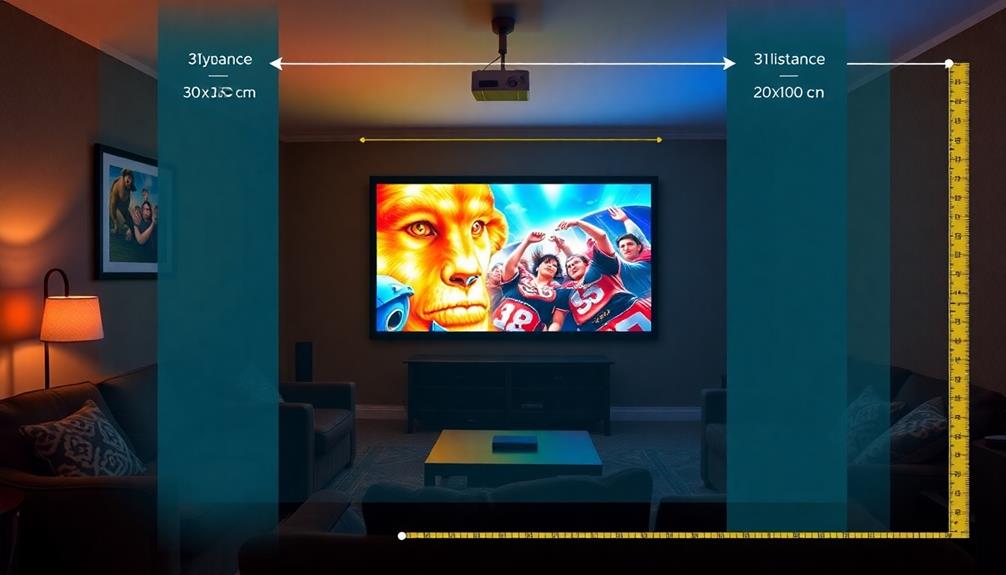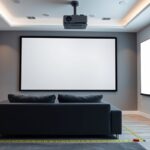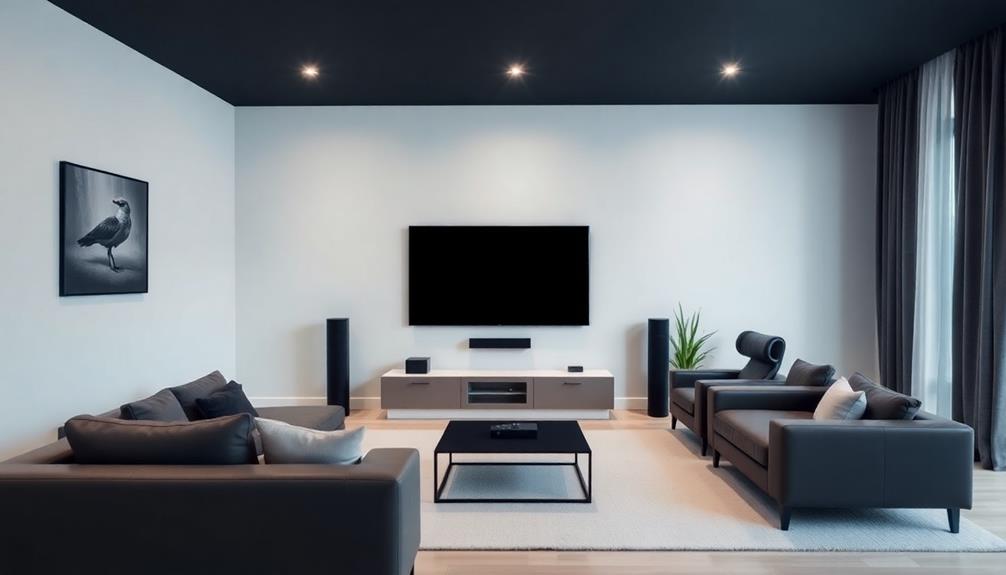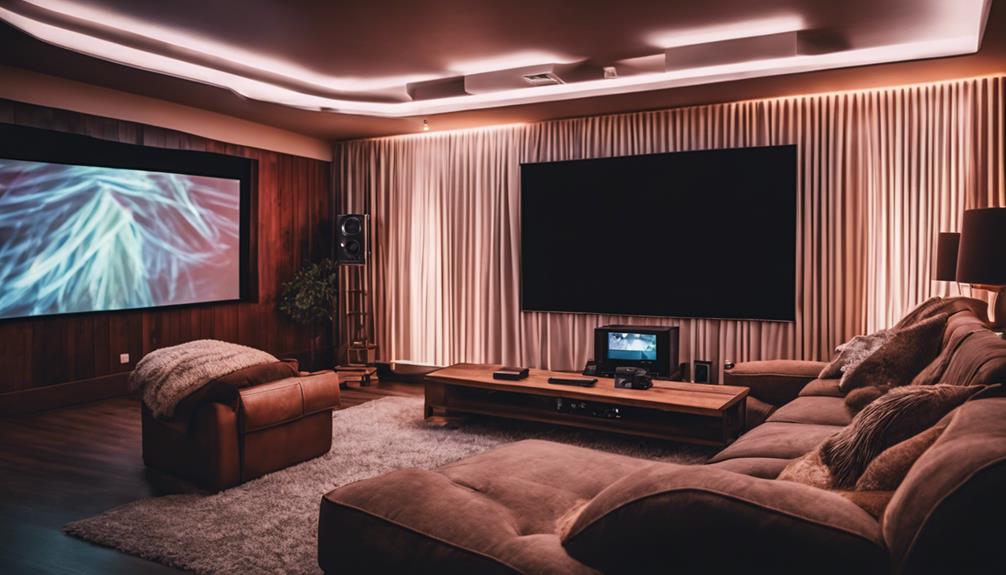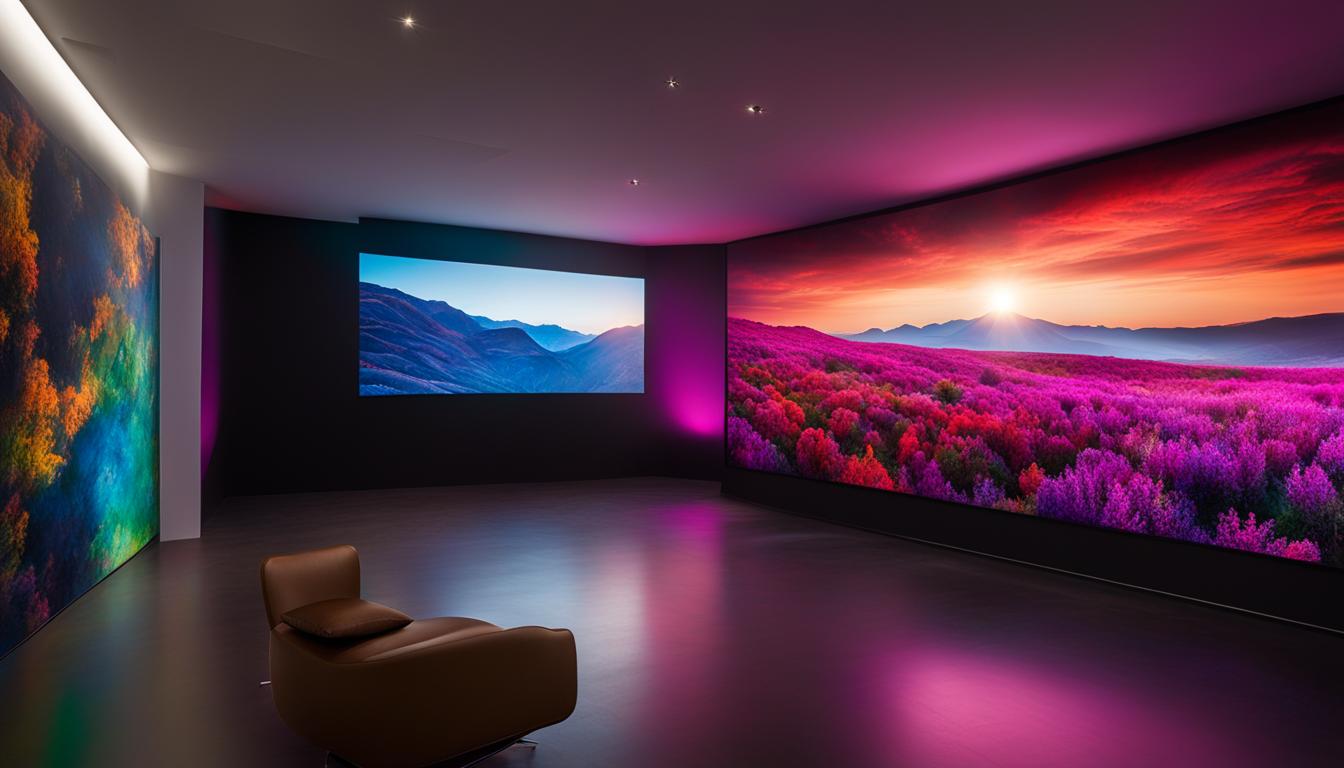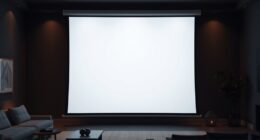Understanding projector throw ratios is key to picking the right projector for your space. The throw ratio (TR) is the distance from the projector to the screen relative to the screen's width. Short throw projectors are perfect for small rooms, as they can project large images from close distances. For larger spaces, standard or long throw projectors work best. Calculate the required throw distance by multiplying the desired screen width by the TR. This guarantees your projector provides a clear, sized image suited to your room's layout. Stick around to explore more about making an informed choice!
Key Takeaways
- Throw ratio (TR) determines projector placement and image size, with short throw, standard throw, and long throw options available for different room sizes.
- Calculate throw distance using the formula D = Width (W) x Throw Ratio (R) for accurate projector positioning.
- Choose ultra-short throw projectors for confined spaces and long throw projectors for larger venues to maximize image quality.
- Ideal viewing distance should be 1.5 to 3 times the screen width, depending on the content resolution to enhance viewing experience.
- Regularly troubleshoot common issues like focus, overheating, and connectivity to maintain optimal projector performance during use.
Definition of Throw Ratio
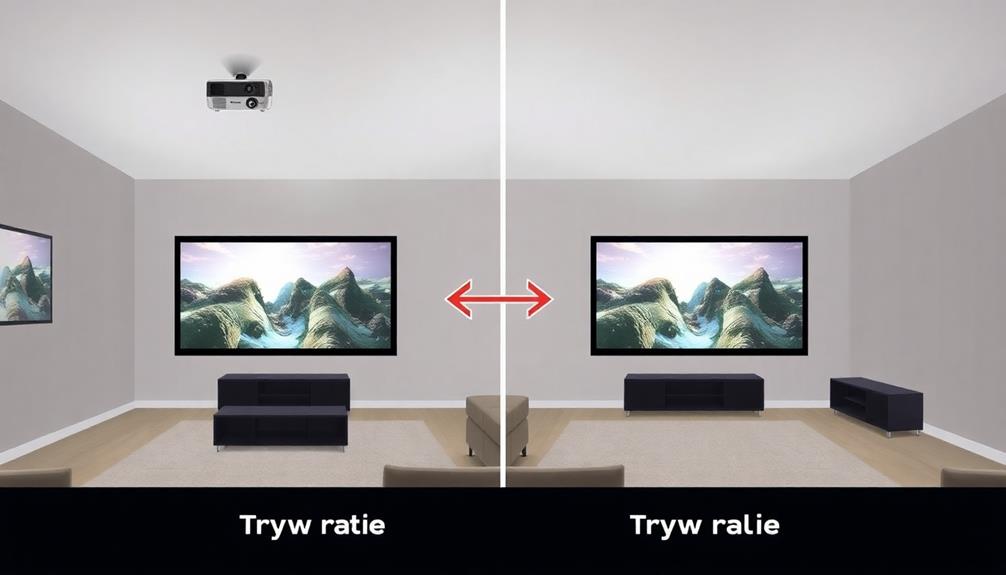
When it comes to setting up a projector, understanding the throw ratio is vital. The throw ratio is the relationship between the distance from the projector lens to the screen (D) and the width of the projected image (W), expressed as D/W. For instance, if you have a throw ratio of 2.0, it means you'll need to place the projector twice the screen width away from your screen to achieve the desired image size.
Knowing how to select the right projector can enhance your viewing experience, similar to choosing the best heat pump for maximum comfort in your home.
This dimensionless ratio plays an essential role in determining projector placement and ensuring that the image fits well within the screen. Projector throw ratios can vary greatly; you might encounter short throw (less than 1:1), standard throw (1:1 to 2:1), and long throw (greater than 2:1) projectors.
Knowing the throw ratio helps you determine which type is best for your space. It's important to evaluate the ideal viewing distance as well, as this distance will impact how viewers perceive the image's clarity and size.
Importance of Throw Ratios
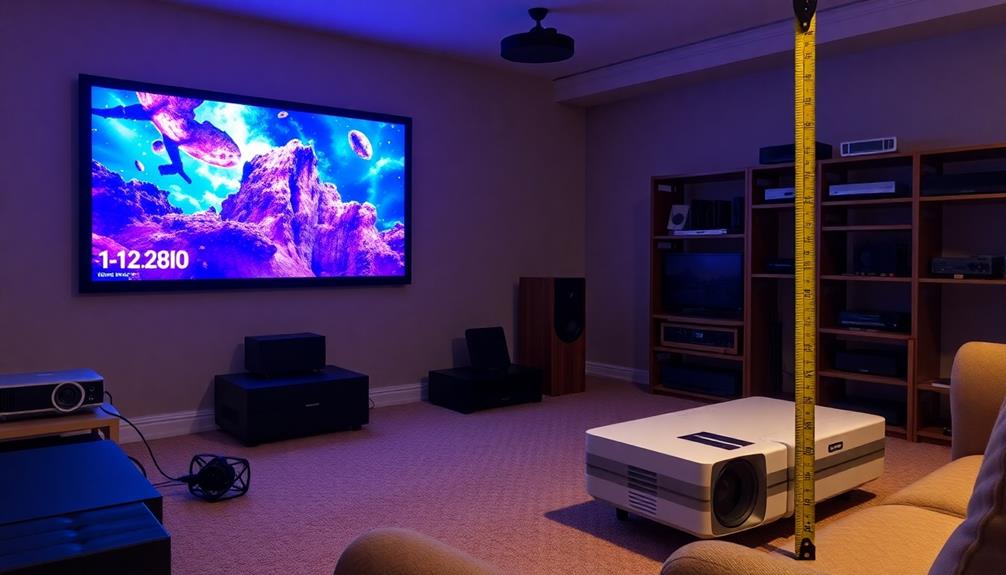
Understanding throw ratios not only helps you determine where to place your projector but also greatly impacts the overall viewing experience. The throw ratio indicates the distance the projector needs to be from the screen to achieve a specific image size. For instance, a throw ratio of 2.0 means your projector should be positioned at double the screen width distance. This is essential for obtaining the ideal image quality and can enhance the ambiance of your viewing area, especially when combined with calming decor elements like textured fabrics that add warmth and comfort.
When selecting a projector, knowing the throw ratio helps you choose the right type for your room size. If you're working in a confined space, an ultra-short throw projector is ideal, while larger venues may benefit from long throw projectors. Different models have varying throw ratios, typically ranging from 1:1 to over 2:1, influencing their suitability for home theaters, classrooms, or auditoriums.
Accurate calculations involving throw ratios can prevent installation errors. This guarantees your projector is positioned correctly for peak performance. Utilizing tools like projector calculators simplifies the process, allowing you to easily calculate the necessary distances for an effective setup.
Types of Throw Ratios
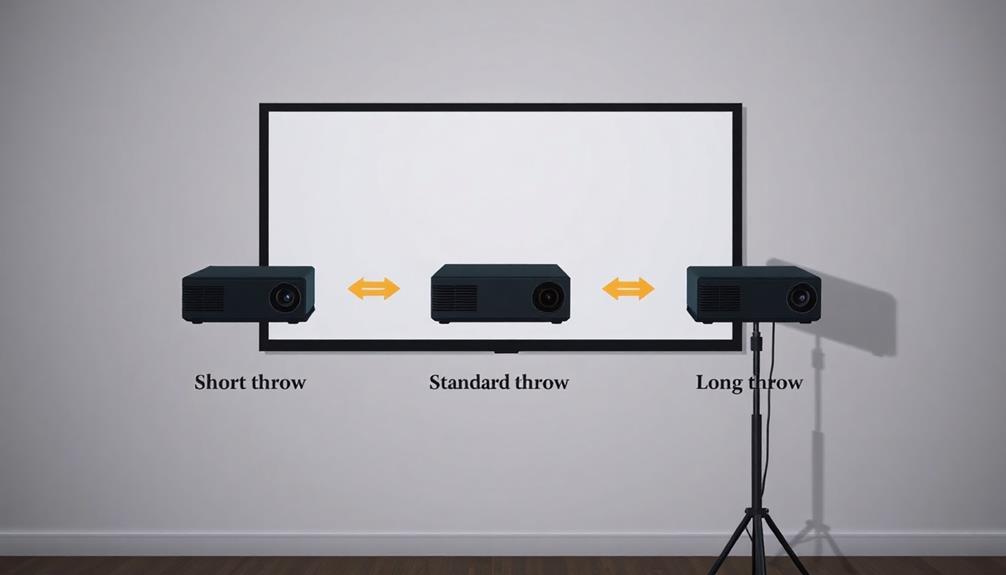
When choosing a projector, the throw ratio plays an essential role in how you set it up.
Understanding the different types of throw ratios can greatly impact your viewing experience, especially when considering factors like top projectors for gaming enthusiasts that may require specific setup conditions.
You can find options like ultra short-throw projectors for tight spaces, standard throw projectors for a versatile range, and long throw projectors for larger venues.
Understanding these types will help you select the right projector for your needs.
Ultra Short-Throw Projectors
Ultra short-throw projectors stand out for their ability to deliver impressive image sizes from a remarkably short distance, typically ranging from just 3 to 20 inches away from the screen.
With a throw ratio of less than 0.4:1, these projectors can create large images, making them perfect for small spaces like classrooms or home theaters. For instance, you can achieve a stunning 100-inch image with an ultra short-throw projector positioned just a few inches away, maximizing your available space.
One of the key advantages of ultra short-throw projectors is their advanced lens technology. This innovation minimizes distortion and maintains excellent image quality, even when projected from close range.
As a result, you won't have to compromise on clarity or detail, which is essential for presentations or educational purposes.
These projectors are increasingly popular for interactive applications, where being close to the screen enhances user engagement.
Whether you're teaching a class or giving a presentation, an ultra short-throw projector can transform your experience, allowing for dynamic interactions without the hassle of bulky equipment.
Standard Throw Projectors
Standard throw projectors serve as a versatile solution for various settings, typically boasting a throw ratio between 1:1 and 2:1. They're ideal for medium to large rooms like classrooms and conference halls.
Here are three key benefits of using standard throw projectors:
- Flexible Placement: With a 1.5:1 throw ratio, projecting a 100-inch image requires about 150 inches (or 12.5 feet) of distance from the lens to the projector screen.
- Image Size Versatility: They allow significant space for different image sizes, accommodating various room layouts and ceiling heights.
- Adjustable Focus: Equipped with zoom lenses, these projectors let you adjust the throw distance without moving the unit, enhancing placement flexibility.
Understanding the specific throw ratio of your standard throw projector is essential for achieving ideal image clarity.
Miscalculating the distance from the lens can lead to installation errors that compromise your viewing experience.
Long Throw Projectors
Long throw projectors are designed for large venues, offering impressive image sizes from significant distances. With a throw ratio greater than 2:1, these projectors require considerable projector distance to achieve your desired image size. For instance, a long throw projector with a 7.5:1 throw ratio needs to be placed 750 inches away to project a 100-inch image. This makes them ideal for auditoriums and other spacious environments.
One of the key benefits of long throw projectors is their ability to deliver higher brightness and image quality. They maintain clarity over longer distances, ensuring your audience receives a vibrant viewing experience.
However, since they often feature fixed lenses, careful planning of projector placement is essential. You can't just adjust the throw ratio on the fly; you need to know exactly where to set up.
These projectors are best suited for dedicated projection environments where there's enough space to accommodate the necessary distances. If you're working with a larger venue, long throw projectors are your best bet for achieving stunning visuals that captivate your audience.
Calculating Throw Distance
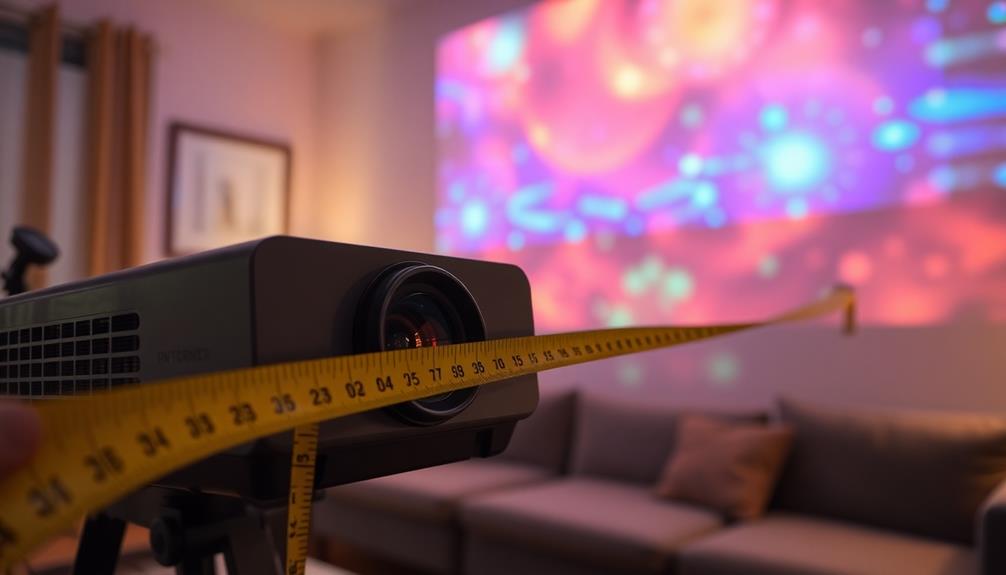
Understanding how to calculate throw distance is essential for achieving the best image quality from your projector. Here are three key points to keep in mind:
- Formula: To calculate the throw distance (D), use the formula D = Width (W) x Throw Ratio (R).
- Example: If your screen width is 100 inches and your projector has a throw ratio of 1.5, your throw distance will be 150 inches (12.5 feet).
- Short Throw Projectors: These projectors, with throw ratios of 0.4 or less, can create large images from very close distances, perfect for small spaces.
To determine the throw distance for your desired screen size, start by measuring the width of the image you want to project.
Then, multiply that width by your projector's throw ratio. For instance, a projector with a throw ratio of 2.0 requires you to place it twice the width of the screen away.
Using a projection calculator can also help you calculate the throw accurately, ensuring that you position your projector correctly for peak performance.
Using Throw Ratios for Setup
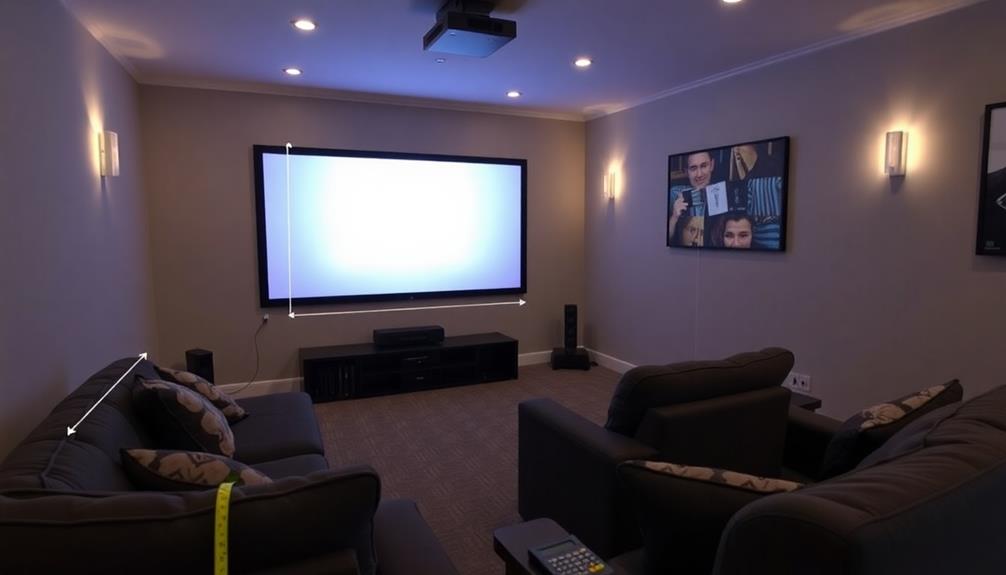
When setting up your projector, knowing the throw ratio is essential for achieving the best image quality and placement.
To determine the ideal projector placement, you can use the formula Distance (D) = Throw Ratio (R) x Screen Width (W). For instance, if your projector has a throw ratio of 2.0, you'll need to position it 12 feet away from a 6-foot wide screen to get the correct image size.
If you're working with limited space, short throw projectors are a fantastic option. With throw ratios of 0.4 or less, these projectors can be placed just a few feet away from the screen, perfect for smaller rooms.
Additionally, projectors equipped with zoom lenses offer flexibility, allowing you to adjust the placement based on their throw ratio range. For example, a projector with a range of 1.2 to 3.0 can be positioned anywhere from 120 inches to 300 inches away from a 100-inch screen.
Guidelines for Viewing Distance
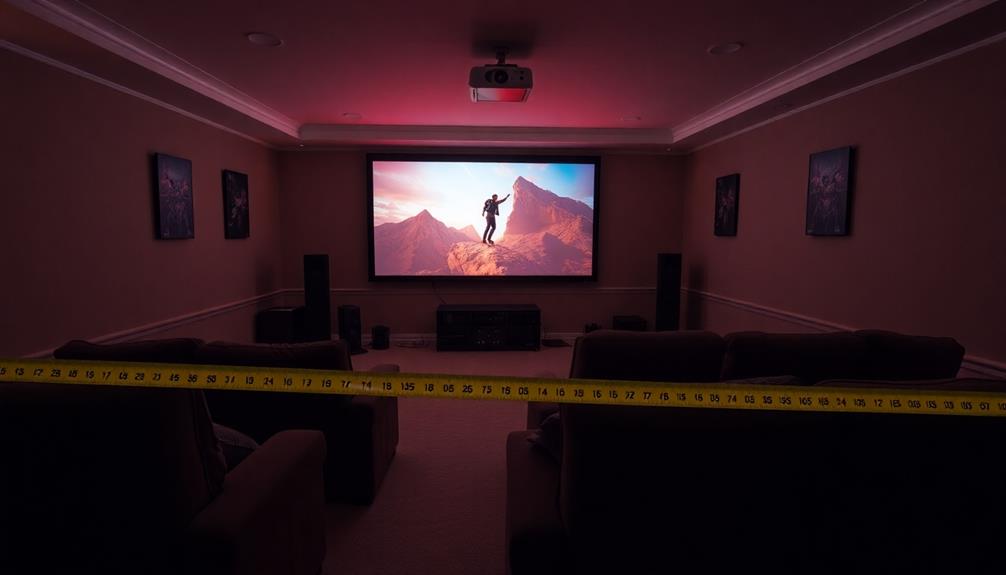
Determining the perfect viewing distance is essential for an enjoyable projector experience. An ideal viewing distance helps you appreciate the quality of your projector while minimizing eye strain.
Here are three key points to take into account:
- The 4/6/8 Rule: Sit at a distance of 4, 6, or 8 times the screen height for comfort.
- SMPTE Guidelines: For HD content, aim for 1.5 times the screen width; for standard definition, go for 3 times the width.
- Projector Resolution Matters: Higher resolutions allow you to sit closer without noticing pixelation.
For example, if you're using a 100-inch screen with a height of about 49 inches, your perfect viewing distances range from approximately 16.33 feet to 32.67 feet.
You can also utilize projector screen calculators to help you determine the proper viewing distance based on your screen size and specific projector resolution.
Choosing the Right Projector
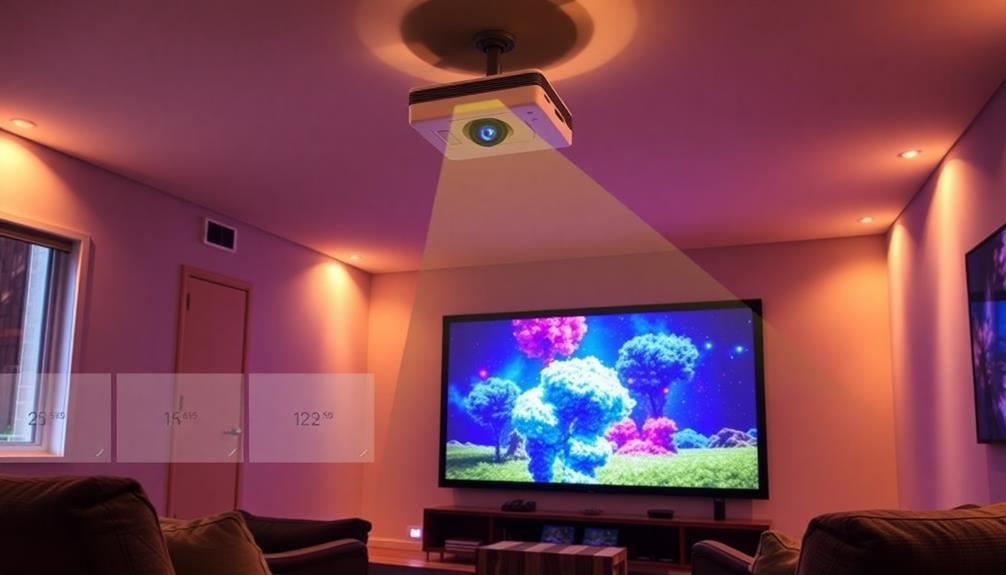
When you're choosing a projector, start by considering your room size and how you plan to use it.
The type of projector, whether standard, short throw, or ultra short throw, will greatly impact the image size and placement.
Make sure to match the projector's specifications with your specific requirements for the best viewing experience.
Room Size Considerations
Selecting the right projector for your space hinges on understanding your room's size and layout. To make this choice easier, consider these key factors:
- Room Size: Smaller rooms often benefit from short throw projectors (0.4:1) that can project large images from a short distance, while larger spaces may need standard (1:1 to 2:1) or long throw projectors (>2:1).
- Projector Distance: A projector with a throw ratio of 2.0 requires placement at twice the width of the image. For example, for a 100-inch screen, you'd need about 17 feet between the projector and the screen.
- Utilizing Tools: Use a projector calculator to determine the ideal throw distance based on your desired image size and projector specifications.
Always consider the layout of the room, including furniture placement and viewing angles. This guarantees that everyone can enjoy clear visibility.
Image Size Requirements
Understanding image size requirements is vital for achieving the best viewing experience in your space. Start by measuring the desired screen width, as this greatly impacts the throw ratio you'll need.
For instance, if you want a 100-inch image, a projector with a 1.5:1 throw ratio must be positioned 150 inches away from the screen to deliver the right image size.
Getting the projector placement right is important. A throw ratio of 2.0 means you'll need to place the projector twice the screen width away, so careful calculations are necessary.
If you're working with limited space, consider short throw projectors that have ratios below 1:1. These allow you to create larger images without requiring considerable distance between the projector and the screen, making them perfect for smaller rooms.
Projector Type Selection
Choosing the right projector type can greatly enhance your viewing experience. Consider these three factors when making your selection:
- Room Size: Assess your space to determine whether you need a short throw projector for compact areas or a long throw projector for larger rooms.
- Throw Ratio: Understand the throw ratio of each model. For instance, short throw projectors typically have a ratio of 0.4 to 1, while long throw projectors exceed 2:1, ideal for expansive home theater setups.
- Flexibility: If your setup requires flexibility, consider a projector with a zoom lens. These allow you to adjust the throw ratio, accommodating distances from 120 to 300 inches for a 100-inch screen.
Always consult the projector specifications before finalizing your choice. For example, a projector with a 1.5:1 throw ratio needs 150 inches of distance to project a 100-inch image.
Troubleshooting Common Issues
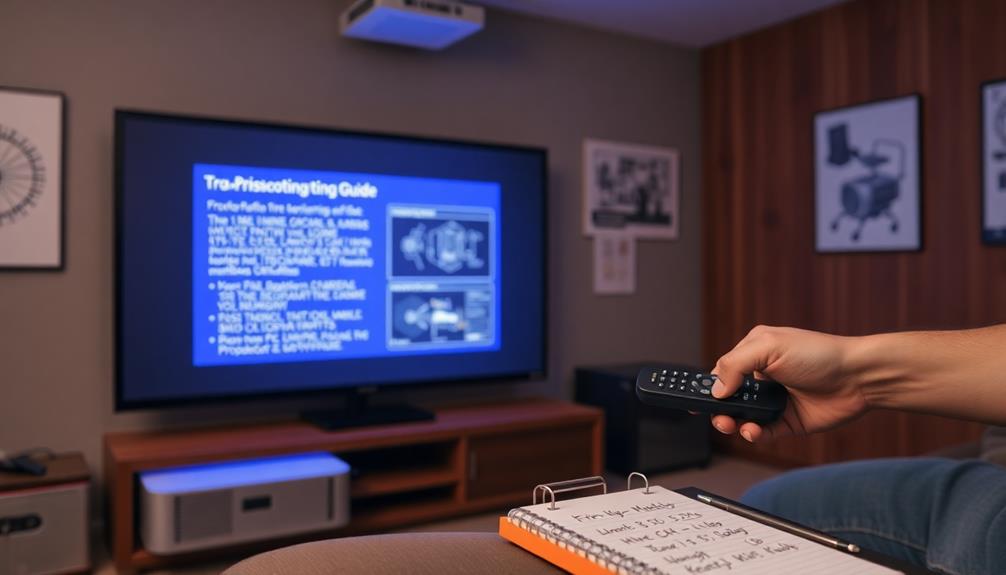
Troubleshooting common issues with your projector can save you time and frustration during significant presentations or movie nights. Here are some typical problems and solutions to take into account:
| Issue | Solution |
|---|---|
| Image clarity is poor | Check the focus and distance settings. Verify the throw ratio depends on the projector and the screen setup. |
| Overheating | Regularly clean the projector's filters and keep it in a well-ventilated area. |
| Lagging issues | Confirm all connections are secure and compatible. |
| Software glitches | Update the projector's firmware periodically. |
When image clarity is poor, it might be due to incorrect focus or the distance from the screen. Remember that the throw ratio depends on how far you place the projector from the screen to achieve ideal clarity. Regular maintenance, like cleaning the filters, is vital for preventing overheating, which can lead to performance issues. By addressing these common problems, you can guarantee that your projector operates smoothly, giving you the best experience possible during your viewing or presentation events.
Frequently Asked Questions
What Is a Good Throw Ratio for Projectors?
A good throw ratio for projectors usually ranges from 1.5:1 to 2.5:1. If you're tight on space, consider a short throw projector. For larger areas, long throw options might work better for you.
How Do I Choose the Right Size Projector for My Room?
To choose the right size projector for your room, measure your space, decide on screen size, and consider throw ratios. Guarantee you balance image quality with viewing distance for the best experience.
How Do I Choose an Aspect Ratio for My Projector?
To choose an aspect ratio for your projector, consider the content you'll display. If you're watching movies, go for 16:9. For presentations, 4:3 might work better. Match the ratio to your screen dimensions to avoid distortions.
What Is 1.5 Throw Ratio Projector?
When it comes to projectors, a 1.5 throw ratio means you need 1.5 feet of distance for every foot of image width. It's a sweet spot, perfect for medium rooms like classrooms or home theaters.
Conclusion
In summary, understanding throw ratios is essential for creating the perfect viewing experience in your space. By selecting the right projector based on your room's dimensions and your audience's needs, you can transform any wall into a cinematic masterpiece. Remember, the right setup can make your movie nights feel like you're at the biggest blockbuster premiere! So explore the world of throw ratios, and get ready to elevate your entertainment game to astronomical heights!
